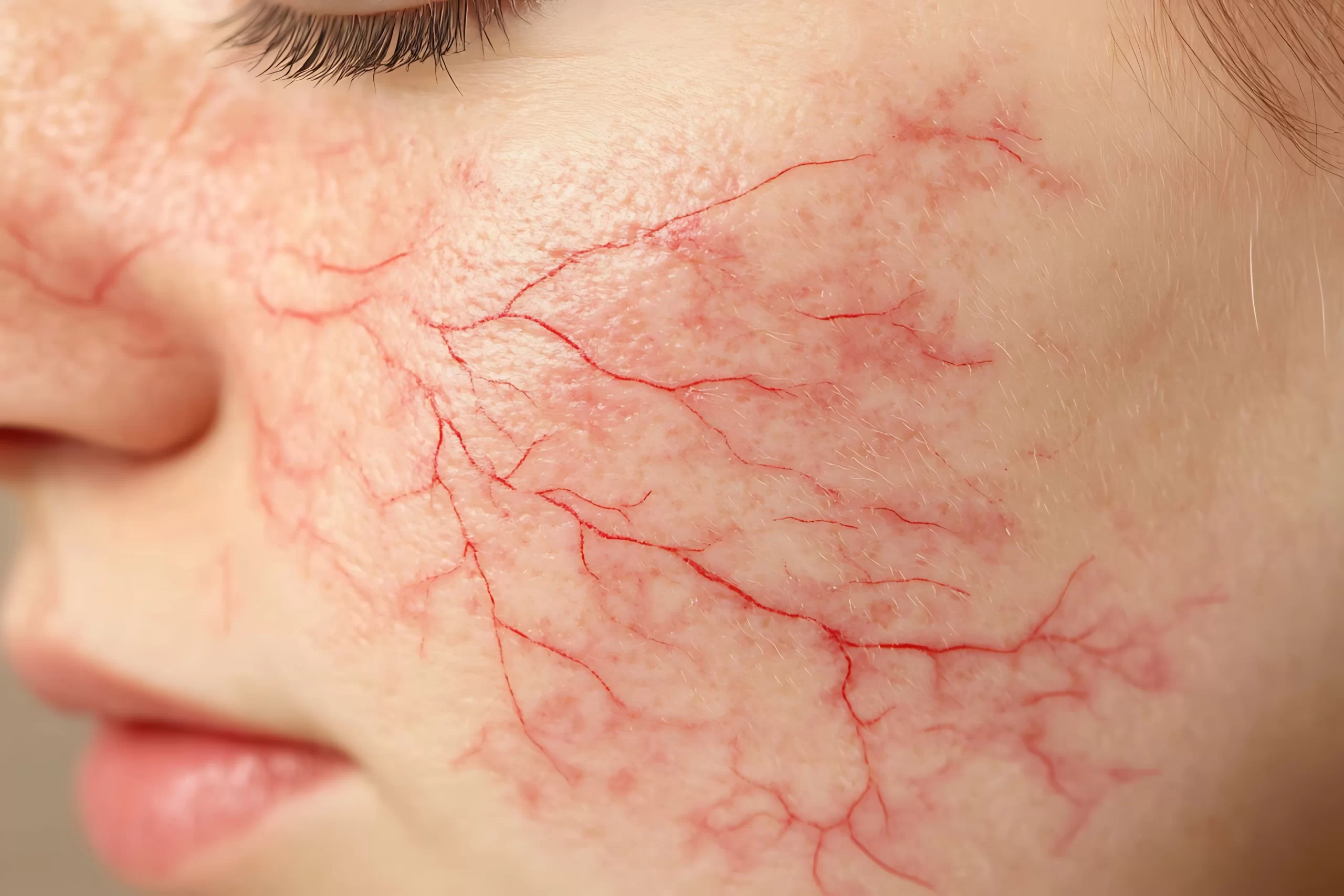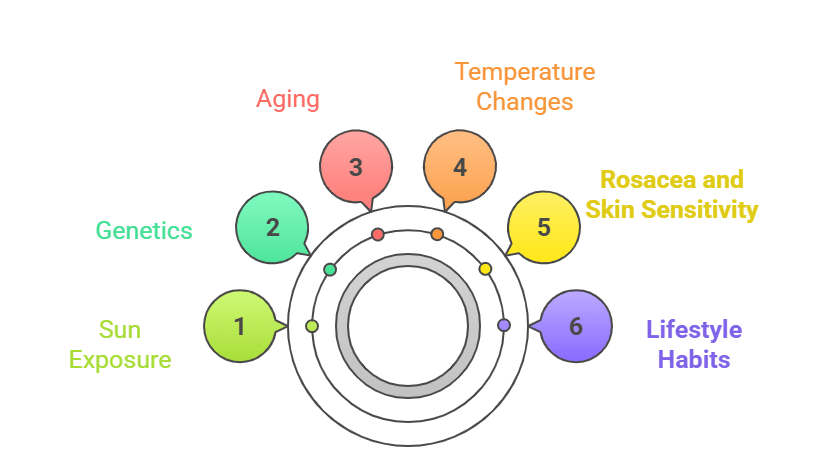What Causes Facial Veins and How to Prevent Them
Quick Summary:
1.Sun Damage Weakens Veins – Prolonged UV exposure breaks down collagen and damages capillary walls, leading to visible facial veins, especially on the nose and cheeks.
2.Genetics and Aging Play a Major Role – Family history and natural aging reduce skin elasticity, making veins more prominent over time.
3.Lifestyle Triggers Matter – Excessive alcohol use, smoking, and sudden temperature changes increase the risk of developing facial veins.
4.Prevention Starts with Protection – Using sunscreen daily, maintaining a gentle skincare routine, and eating antioxidant-rich foods can help prevent facial veins.
5.Professional Treatments Are Effective – Laser therapy and sclerotherapy safely target and remove visible facial veins, restoring smoother, clearer skin.
Facial veins, often seen as fine red, blue, or purple lines beneath the skin, can appear suddenly and make many people feel self-conscious about their appearance. In this blog, we’ll break down what causes facial veins, uncover the most common triggers behind their appearance, and share simple yet effective tips on how to prevent facial veins from forming or worsening. We’ll also touch on proven treatment options to help you achieve clearer, healthier-looking skin.
Facial veins are primarily caused by factors such as sun exposure, aging, genetics, and skin trauma. Lifestyle habits like frequent exposure to extreme temperatures, smoking, and alcohol consumption can also make them more noticeable. To minimize the risk, protect your skin by wearing sunscreen and a wide-brimmed hat, avoiding sudden temperature changes, and following a gentle skincare routine. Reducing alcohol and smoking, along with properly managing conditions like rosacea, can further lower your chances of developing facial veins over time.

Understanding Facial Veins
Facial veins, also known as spider veins or broken capillaries, are small blood vessels that become visible when they expand or break near the surface of the skin. These veins are commonly seen on the cheeks, nose, and chin. While they’re harmless in most cases, they can impact one’s appearance and confidence.
Unlike varicose veins that occur deeper in the legs, facial veins are typically a surface-level cosmetic concern. However, their appearance may also signal skin sensitivity or early signs of vascular weakness, particularly among people with fair or sun-damaged skin.
Common Causes of Facial Veins

1. Sun Exposure
Excessive exposure to ultraviolet (UV) rays is one of the leading causes of facial veins. When your skin absorbs too much sun, UV radiation weakens the tiny blood vessel walls and reduces collagen, the protein responsible for keeping your skin firm and elastic. As a result, the vessels expand and become more visible through the skin’s surface.
Over time, this sun-induced damage leads to broken capillaries, redness, and uneven skin tone, especially around the nose, cheeks, and forehead. People who spend long hours outdoors, such as runners, gardeners, or outdoor workers, are more likely to experience these effects if they don’t consistently use sun protection.
2. Genetics
Your family history can play a big role in whether or not you develop facial veins. If your parents or grandparents had visible veins, there’s a strong chance you may, too. Genetics influence the thickness and elasticity of your skin as well as the strength of your blood vessel walls. If you have fair or delicate skin, you may be more prone to seeing these small red or blue veins on your face, even at a younger age.
3. Aging
As we grow older, our skin naturally becomes thinner and less elastic due to a decrease in collagen and elastin production. This makes blood vessels more fragile and visible. Around your 40s and beyond, even minor pressure or temperature changes can cause veins to break or expand. Additionally, the body’s ability to repair damaged skin slows down with age, allowing visible veins to linger longer than they did before.
4. Temperature Changes
Sudden or frequent exposure to extreme temperatures can cause facial veins to appear faster than you might expect. When moving from hot to cold environments, like stepping out of an air-conditioned building into summer heat, your blood vessels expand and contract rapidly. Over time, this repeated process can weaken the vessel walls. Regularly taking hot showers, using saunas, or spending extended time in freezing weather can also stress your capillaries and make facial veins more prominent.
5. Rosacea and Skin Sensitivity
Individuals with rosacea or sensitive skin are at higher risk of developing visible veins. Rosacea causes chronic inflammation, which leads to persistent redness and swelling that put constant pressure on the capillaries beneath the skin. Over time, these delicate vessels can rupture or dilate, creating spider-like veins that don’t fade on their own. Properly managing rosacea through medication, skincare, and lifestyle changes can help reduce flare-ups and protect your skin’s appearance.
6. Lifestyle Habits
Unhealthy habits such as excessive alcohol consumption, smoking, and poor diet are also significant contributors. Alcohol dilates the blood vessels, which can make them more likely to burst, while smoking damages collagen and slows down circulation. Poor nutrition, dehydration, and lack of antioxidants weaken both your skin and your vascular system. Making mindful changes to your lifestyle can go a long way in maintaining strong, healthy blood vessels and preventing new facial veins from forming.
If you already notice visible veins and want to explore safe, advanced treatment options, visit our Facial Veins Treatment page to learn more about professional care designed to restore smooth, even-toned skin.
How to Prevent Facial Veins
1. Protect Your Skin from the Sun
Wearing sunscreen daily is one of the easiest and most effective ways to prevent facial veins. Choose a broad-spectrum SPF 30 or higher and reapply every two hours if you’re outdoors. Pair sunscreen with a wide-brimmed hat and sunglasses for extra protection. Avoid prolonged sun exposure during peak hours (10 AM–4 PM), and don’t forget areas like your nose and cheeks, which are most vulnerable to sun damage.
2. Be Gentle with Your Skin
Rough exfoliation and strong chemical treatments can aggravate your skin and lead to broken capillaries. Instead, choose gentle cleansers and soothing products designed for sensitive skin. Look for ingredients such as vitamin C, niacinamide, and aloe vera to strengthen your skin barrier and improve circulation without irritation. Remember, being consistent with a gentle skincare routine is better than using harsh products occasionally.
3. Limit Alcohol and Smoking
Alcohol and tobacco both have a major impact on blood vessel health. Alcohol dilates capillaries, increasing the risk of rupture, while smoking restricts oxygen flow to the skin and accelerates aging. Reducing or eliminating these habits can significantly lower your chances of developing facial veins and improve your overall complexion.
4. Avoid Extreme Temperatures
Try not to expose your face to sudden temperature changes. If you love long, hot showers or saunas, consider lowering the heat a little. Similarly, during winter, protect your face with scarves and avoid washing it with very hot or cold water. Using a humidifier indoors can also help prevent skin dryness that makes capillaries more visible.
5. Maintain a Healthy Diet
Your skin and blood vessels reflect what you eat. A diet rich in antioxidants, vitamin C, and omega-3 fatty acids can help strengthen capillary walls and improve circulation. Add foods like blueberries, spinach, salmon, citrus fruits, and green tea to your meals. Staying hydrated also helps maintain healthy, elastic skin, reducing the risk of broken veins.
6. Consider Professional Treatments
If facial veins persist or become more noticeable, don’t worry, modern vein treatments are safe, fast, and effective. Laser therapy uses precise light energy to shrink visible veins, while sclerotherapy involves injecting a gentle solution that causes damaged veins to fade over time. These minimally invasive options can restore a clearer, more even skin tone without downtime.
You can learn more about these advanced, doctor-recommended solutions on our Facial Veins Treatment page, where our specialists explain each procedure and what kind of results you can expect.
Final Thoughts
Facial veins may be common, but they don’t have to be permanent. By understanding the causes of facial veins and taking preventive measures, you can protect your skin and reduce their appearance. And if you’re already dealing with visible veins, professional treatments can help restore a smooth, healthy-looking complexion.
Ready to take the next step toward clearer skin? Contact us today to schedule your consultation with one of our experienced vein specialists. We’re here to help you achieve lasting results and renewed confidence.


